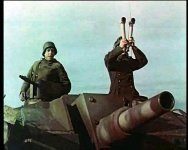Wayne,
you beat me by 20 minutes .... it is not a rangefinder.
I also have been checking on that and YES, it is a Scherenfernrohr (scissors telescope)
More information here ....
http://www.panzeraufgd.co.uk/optics.html
This hybrid between binoculars and a periscope enabled the observer to remain safely concealed in dug outs, behind walls or even tree trunks with only the objective lens visible to the enemy. 1905 saw the design refined further with an army-issue variant and a field artillery model being trialed and adopted. Naturally other countries produced their own versions of the scissors telescope and when World War I broke out both opposing armies all along the Western Front observed each other from their trenches using such equipment. By World War II the design remained virtually unchanged except for an upgrade in magnification to 10 x 50 and continued to be a useful tool in the Wehrmacht for general observation (in both vehicles and on the ground) and for artillery fire observation and direction throughout the war.
John
 TIGER5 by Wayne 556517, on Flickr
TIGER5 by Wayne 556517, on Flickr TIGER4 by Wayne 556517, on Flickr
TIGER4 by Wayne 556517, on Flickr TIGER3 by Wayne 556517, on Flickr
TIGER3 by Wayne 556517, on Flickr TIGER2 by Wayne 556517, on Flickr
TIGER2 by Wayne 556517, on Flickr TIGER1 by Wayne 556517, on Flickr
TIGER1 by Wayne 556517, on Flickr TIGER5 by Wayne 556517, on Flickr
TIGER5 by Wayne 556517, on Flickr TIGER4 by Wayne 556517, on Flickr
TIGER4 by Wayne 556517, on Flickr TIGER3 by Wayne 556517, on Flickr
TIGER3 by Wayne 556517, on Flickr TIGER2 by Wayne 556517, on Flickr
TIGER2 by Wayne 556517, on Flickr TIGER1 by Wayne 556517, on Flickr
TIGER1 by Wayne 556517, on Flickr

